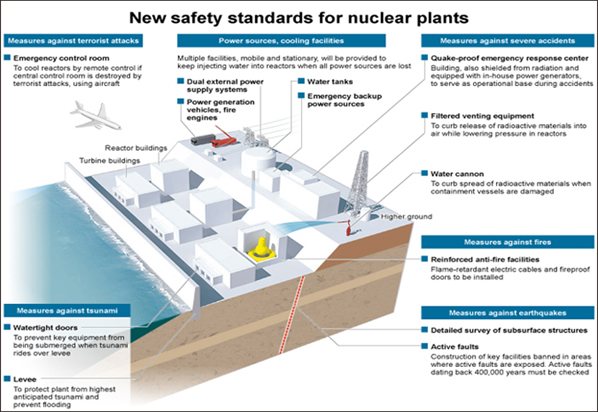Fukushima Impact: A New Nuclear Safety Regulations in Japan
In a bid to restore public trust in the country’s nuclear energy programme and to assuage the concerns of the anti-nuclear groups, Japan has enacted a new nuclear safety regime which came into effect on July 8. The newly created Nuclear Regulatory Authority (NRA) imposes stricter safety measures on operators to avoid recurrence of Fukushima like nuclear reactor meltdown. However, the public remains cautious and continues to be deeply concerned about nuclear safety.
The new regulatory authority, based on various investigation reports on Fukushima, identified certain vulnerability and failures in Japan’s existing nuclear system. Therefore, it has made it mandatory for operators to install defences that can prevent meltdowns from being caused by natural disasters as well as terrorist attacks. The NRA calls for:
Safety measures against natural phenomena (e.g., tornados, forest fires) and external man-made hazards (e.g., an aircraft crash), the reliability of off-site power supply, ultimate heat sink and the functions of SSCs1, as well as fire protection measures on site should be strengthened.2
When the Fukushima disaster took place, the operator, Tokyo Electric Power Company (TEPCO) and a section of nuclear scientists who investigated the incident argued that the meltdown resulted when generators to supply power to Emergency Core Cooling System of the nuclear reactor failed as it was inundated by the sea water post-tsunami.3 Learning from the lessons, the new regulatory authority makes it mandatory for operators to reinforce multiple “off-site power supply” so that the power supply to the core cooling system of the particular nuclear reactor is not disrupted in the event of a disaster and a possible nuclear crisis can be averted.
Some of the Key safety measures (also see the illustration 1) suggested by the NRA4 are as follows:
- Installation of “filtered containment vessel venting system” for heat removal in the event of “severe core damage”.
- Installation of “permanent and portable equipments such as pump trucks, pressure resistant hoses” dispersed over a wide area for “injecting coolant” in the event of severe core damage to cool melted core.
- Installation of “hydrogen concentration control equipment” for preventing a hydrogen explosion in a containment vessel.
- Installation of “hydrogen and radioactive material concentration measurement equipments” to measure radioactivity during severe core damage.
- Installing portable “spray equipment” (spray headers, spray lines, pump trucks) near the nuclear plant to mitigate fuel damage.
- Setting up additional “emergency control room” to monitor the plant in case operators have to evacuate main control room due to natural or man made disaster.
- Building seawalls near the nuclear plant which can withstand the tsunami.
- No construction of nuclear facilities near the active seismic faults.

Illustration1, Source: The Asahi Shimbun, July 9, 2013.
These upgrades will cost more to the utilities. The Japanese media has quoted that it will cost an additional one trillion Yen to all the nuclear operators and the NRA has granted a five-year grace period for putting some of the safety measures.
The government of Japan, under public pressure, has disbanded the previous nuclear regulator National and Industrial Safety Agency (NISA) which was under the Ministry of Economy Trade and Industry. The Japanese, since Fukushima, have been critical of the perceived cosy ties between the regulators and business interests which they feel has undermined nuclear safety. The Diet panel which investigated the Fukushima incident criticised NISA for acting like a “slave” to the electric power companies.5 Now a new NRA has been established under the Ministry of Environment by integrating NISA and the Nuclear Safety Commission which was under the Cabinet Office. The day the NRA came to effect, some five utilities presented its credential to NRA seeking its approval to restart their 10 idled reactors. Other operators are following suits. This suggests that a few more nuclear reactors6 will go online soon, hinting clearly that the new Liberal Democratic Party (LDP) government is in no mood to implement the “zero nuclear policy” drafted by the previous Democratic Party of Japan (DPJ) government which pledged to ease country’s dependence on nuclear energy by 1930s.
The new measures, however, has not changed the public sentiments which left a deep psychological impact. To recall, the incident forced more than 100,000 people to evacuate the area and a 20 km ‘no go zone’ in Fukushima still remains. The Asahi Shimbun opinion poll conducted a day before the NRA came to force found that some 48 percent respondent opposed the re-opening of the nuclear plants while only 34 percent support the move.7 Similarly, a Kyodo News poll found that 54.3 per cent of those polled opposed the restart of reactors even if they passed the NRA’s safety assessment while 37.2 per cent supported it.8 The Japanese remains wary to the re-starting of idled reactors primarily because a research conducted by seismologists commissioned by the government have predicted that yet another mega quake of the magnitude of 8-9 is likely to hit Japan within a few decades.9 Civic group have been protesting the move10, fearing yet another Fukushima-type nuclear disaster. A section of the Japanese media has also voiced concerns for granting a grace period of five years to the nuclear utilities to install safety equipments stating that the “nuclear industry would be gambling that a disaster won’t strike in the interim.”11
These concerns apart, there are certain constituencies, including the Fukushima community, who want to re-start the idled reactors as the revenue generated from nuclear industry remains an important source for drafting the budget of their municipalities. The Yomiuri Shimbun in a survey conducted in January 2013 found that more than 50 per cent of mayors of the host communities and adjoining areas support the restart of nuclear reactors with some riders attached.12
Other groups including the industry and the ruling LDP favour the restart of nuclear reactor because Japan has been meeting its energy requirements through thermal power plants, which has led to increase of electricity rate and has dented the economy as well.
Despite the fact that NRA has enacted strict regulations for re-start of nuclear reactors some of the local governing bodies remain cautious. The government has also urged the operators to take the host community into confidence before the restart of the offline reactors. This is why only those utilities have applied for re-start which have got prior approval of the local governments. Other local authorities who have not given their consent have been asking the operators not to disregard the local opinion. Thus, a kind of impasse continues between the nuclear utilities and the local government.
In spite the new nuclear regulatory regime with better safety mechanism, the revival of nuclear industry in Japan would depend on the nuclear utilities winning the trust and confidence of the nuclear allergic public. This is the biggest challenge.
Views expressed are of the author and do not necessarily reflect the views of the IDSA or of the Government of India.
- 1. SSCs Stands for Structure, System and Components which are critical for nuclear plants safety.
- 2. “Draft New Safety Standards for Nuclear operators”, Nuclear Regulatory Authority, Japan, January 2013, available online at http://www.nsr.go.jp/english/data/new_safety_standards.pdf (Accessed July 11, 2013).
- 3. A section of Japanese scientists, however, believe that the powerful quake caused the nuclear meltdown. For details see, Shamshad A. Khan, “Japan’s Nuclear Energy Debate: A year After Fukushima Nuclear Crisis”, (IDSA Issue Brief), available online at https://idsa.demosl-03.rvsolutions.in/system/files/IB_%20JapansNuclearEnergyDebate_Shamshad.pdf (Accessed July 14, 2013).
- 4. For details see, “Draft New Safety Standards for Nuclear operators”, Nuclear Regulatory Authority, Japan, January 2013, available online at http://www.nsr.go.jp/english/data/new_safety_standards.pdf (Accessed July 11, 2013).
- 5. “New Strict safety standards put nuclear watchdog to the test”, The Asahi Shimbun, July 09, 2013.
- 6. Only two out of 50 nuclear reactors are online in Japan.
- 7. Asahi Shimbun survey quoted in “Utilities seeking restarts have support of pro-nuclear government”, The Asahi Shimbun, July 09, 2013.
- 8. The Kyodo New poll quoted in, “Rushing to restart reactors,” The Japan Times, July 10, 2013.
- 9. Japan has 70% chance of M8-9 quake in Nankai trough within 30 years: Panel, The Japan Times/Kyodo News, May 25, 2013.
- 10. Civic groups protest against restarting nuclear reactors, Mianichi Japan, July 8, 2013.
- 11. “Rushing to restart reactors ( Editorial), The Japan Times, July 10, 2013.
- 12. Half of local leaders back N-starts, The Yomiuri Shimbun, January 7, 2013.








